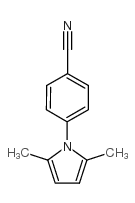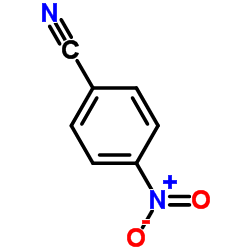119516-86-8
| 中文名 | 1-(4-氰苯基)-2,5-二甲基吡咯 |
|---|---|
| 英文名 | 4-(2,5-dimethylpyrrol-1-yl)benzonitrile |
| 中文别名 | 1-(4-苯氰基)-2,5-二甲基吡咯 |
| 英文别名 |
2,5-Dimethyl-1-(4-cyanophenyl)pyrrole
1-(4-Cyanophenyl)-2,5-diMethylpyrrole |
| 密度 | 1.02g/cm3 |
|---|---|
| 沸点 | 345.9ºC at 760 mmHg |
| 熔点 | 110ºC |
| 分子式 | C13H12N2 |
| 分子量 | 196.24800 |
| 闪点 | 163ºC |
| 精确质量 | 196.10000 |
| PSA | 28.72000 |
| LogP | 2.96578 |
| 蒸汽压 | 5.96E-05mmHg at 25°C |
| 折射率 | 1.573 |
| 储存条件 | 室温 |
| 计算化学 | 1.疏水参数计算参考值(XlogP):2.8 2.氢键供体数量:0 3.氢键受体数量:1 4.可旋转化学键数量:1 5.互变异构体数量:无 6.拓扑分子极性表面积28.7 7.重原子数量:15 8.表面电荷:0 9.复杂度:247 10.同位素原子数量:0 11.确定原子立构中心数量:0 12.不确定原子立构中心数量:0 13.确定化学键立构中心数量:0 14.不确定化学键立构中心数量:0 15.共价键单元数量:1 |
| 更多 | 1. 性状:未确定 2. 密度(g/mL,20℃):未确定 3. 相对蒸汽密度(g/mL,空气=1):未确定 4. 熔点(ºC):110 5. 沸点(ºC,常压):未确定 6. 沸点(ºC,KPa):未确定 7. 折射率:未确定 8. 闪点(ºC):未确定 9. 比旋光度(º):未确定 10. 自燃点或引燃温度(ºC):未确定 11. 蒸气压(Pa,20ºC):未确定 12. 饱和蒸气压(KPa,20ºC):未确定 13. 燃烧热(KJ/mol):未确定 14. 临界温度(ºC):未确定 15. 临界压力(KPa):未确定 16. 油水(辛醇/水)分配系数的对数值:未确定 17. 爆炸上限(%,V/V):未确定 18. 爆炸下限(%,V/V):未确定 19. 溶解性:未确定 |
|
1-(4-Cyanophenyl)-2,5-dimethylpyrrole
SAFETY DATA SHEET Section1. IDENTIFICATION Product name:1-(4-Cyanophenyl)-2,5-dimethylpyrrole Section2. HAZARDS IDENTIFICATION GHS classification
PHYSICAL HAZARDSNot classified
HEALTH HAZARDS Acute toxicity (Oral)Category 3 Category 3 Acute toxicity (Dermal) Acute toxicity (Inhalation)Category 3 Category 2 Skin corrosion/irritation Serious eye damage/eye irritationCategory 2A Not classified ENVIRONMENTAL HAZARDS GHS label elements, including precautionary statements Pictograms or hazard symbols Signal wordDanger Toxic if swallowed, in contact with skin or if inhaled Hazard statements Causes skin irritation Causes serious eye irritation Precautionary statements: Avoid breathing dust/fume/gas/mist/vapours/spray. [Prevention] Use only outdoors or in a well-ventilated area. Do not eat, drink or smoke when using this product. Wash hands thoroughly after handling. Wear protective gloves and eye/face protection. [Response]IF INHALED: Remove victim to fresh air and keep at rest in a position comfortable for breathing. Call a POISON CENTER or doctor/physician. IF SWALLOWED: Immediately call a POISON CENTER or doctor/physician. Rinse mouth. IF IN EYES: Rinse cautiously with water for several minutes. Remove contact lenses, if present and easy to do. Continue rinsing. If eye irritation persists: Get medical advice/attention. IF ON SKIN: Gently wash with plenty of soap and water. If skin irritation occurs: Get medical advice/attention. Remove/Take off immediately all contaminated clothing. Wash contaminated clothing before reuse. Call a POISON CENTER or doctor/physician if you feel unwell. 1-(4-Cyanophenyl)-2,5-dimethylpyrrole Section2. HAZARDS IDENTIFICATION [Storage]Store in a well-ventilated place. Keep container tightly closed. Store locked up. [Disposal]Dispose of contents/container through a waste management company authorized by the local government. Section3. COMPOSITION/INFORMATION ON INGREDIENTS Substance/mixture:Substance Components:1-(4-Cyanophenyl)-2,5-dimethylpyrrole >98.0%(GC) Percent: CAS Number:119516-86-8 2,5-Dimethyl-1-(4-cyanophenyl)pyrrole Synonyms: Chemical Formula:C13H12N2 Section4. FIRST AID MEASURES Inhalation:Remove victim to fresh air and keep at rest in a position comfortable for breathing. Call a POISON CENTER or doctor/physician. Skin contact:Remove/Take off immediately all contaminated clothing. Gently wash with plenty of soap and water. Call a POISON CENTER or doctor/physician. Eye contact:Rinse cautiously with water for several minutes. Remove contact lenses, if present and easy to do. Continue rinsing. If eye irritation persists: Get medical advice/attention. Immediately call a POISON CENTER or doctor/physician. Rinse mouth. Ingestion: Protection of first-aiders:A rescuer should wear personal protective equipment, such as rubber gloves and air- tight goggles. Section5. FIRE-FIGHTING MEASURES Dry chemical, foam, water spray, carbon dioxide. Suitable extinguishing media: Specific hazards arising Take care as it may decompose upon combustion or in high temperatures to from the chemical:generate poisonous fume. Precautions for firefighters: Fire-extinguishing work is done from the windward and the suitable fire-extinguishing method according to the surrounding situation is used. Uninvolved persons should evacuate to a safe place. In case of fire in the surroundings: Remove movable containers if safe to do so. When extinguishing fire, be sure to wear personal protective equipment. Special protective equipment for firefighters: Section6. ACCIDENTAL RELEASE MEASURES Personal precautions,Use extra personal protective equipment (P3 filter respirator for toxic particles). Keep protective equipment and people away from and upwind of spill/leak. Entry to non-involved personnel should emergency procedures: be controlled around the leakage area by roping off, etc. Environmental precautions: Prevent product from entering drains. Methods and materials for Sweep dust to collect it into an airtight container, taking care not to disperse it. containment and cleaning Adhered or collected material should be promptly disposed of, in accordance with up: appropriate laws and regulations. Section7. HANDLING AND STORAGE Precautions for safe handling Technical measures:Handling is performed in a well ventilated place. Wear suitable protective equipment. Prevent dispersion of dust. Wash hands and face thoroughly after handling. Use a closed system if possible. Use a local exhaust if dust or aerosol will be generated. Advice on safe handling: Avoid contact with skin, eyes and clothing. Conditions for safe storage, including any incompatibilities Keep container tightly closed. Store in a cool, dark and well-ventilated place. Storage conditions: 1-(4-Cyanophenyl)-2,5-dimethylpyrrole Section7. HANDLING AND STORAGE Store locked up. Store away from incompatible materials such as oxidizing agents. Packaging material:Comply with laws. Section8. EXPOSURE CONTROLS / PERSONAL PROTECTION Engineering controls:Install a closed system or local exhaust. Also install safety shower and eye bath. Personal protective equipment Respiratory protection: Dust respirator, self-contained breathing apparatus(SCBA), supplied air respirator, etc. Use respirators approved under appropriate government standards and follow local and national regulations. Hand protection:Impervious gloves. Eye protection:Safety goggles. A face-shield, if the situation requires. Skin and body protection: Impervious protective clothing. Protective boots, if the situation requires. Section9. PHYSICAL AND CHEMICAL PROPERTIES Physical state (20°C):Solid Form:Crystal- Powder Colour:Yellow - Deep reddish yellow Odour:No data available pH: No data available Melting point/freezing point:110°C Boiling point/range:No data available Flash point:No data available Flammability or explosive limits: No data available Lower: Upper:No data available No data available Relative density: Solubility(ies): [Water]No data available [Other solvents] Methanol Soluble: Section10. STABILITY AND REACTIVITY Chemical stability:Stable under proper conditions. Possibility of hazardous No special reactivity has been reported. reactions: Incompatible materials: Oxidizing agents Hazardous decomposition Carbon monoxide, Carbon dioxide, Nitrogen oxides (NOx), Hydrogen cyanide products: Section11. TOXICOLOGICAL INFORMATION No data available Acute Toxicity: Skin corrosion/irritation: No data available No data available Serious eye damage/irritation: Germ cell mutagenicity: No data available Carcinogenicity: IARC =No data available NTP =No data available Reproductive toxicity:No data available Section12. ECOLOGICAL INFORMATION Ecotoxicity: No data available Fish: Crustacea:No data available 1-(4-Cyanophenyl)-2,5-dimethylpyrrole Section12. ECOLOGICAL INFORMATION Algae:No data available Persistence / degradability: No data available BioaccumulativeNo data available potential(BCF): Mobility in soil No data available Log Pow: Soil adsorption (Koc):No data available No data available Henry's Law constant(PaM3/mol): Section13. DISPOSAL CONSIDERATIONS Recycle to process, if possible. Consult your local regional authorities. You may be able to dissolve or mix material with a combustible solvent and burn in a chemical incinerator equipped with an afterburner and scrubber system. Observe all federal, state and local regulations when disposing of the substance. Section14. TRANSPORT INFORMATION 6.1: Toxic substance. Hazards Class: UN-No:2811 Toxic solid, organic, n.o.s. Proper shipping name: Packing group:III Section15. REGULATORY INFORMATION Safe management ordinance of dangerous chemical product (State Council announces on January 26, 2002 and revised on February 16,2011): Safe use and production, the storage of a dangerous chemical, transport, loading and unloading were prescribed. SECTION 16 - ADDITIONAL INFORMATION N/A |
| 海关编码 | 2933990090 |
|---|
|
~85% 
119516-86-8 |
| 文献:Rahmatpour, Ali Journal of Organometallic Chemistry, 2012 , vol. 712, p. 15 - 19 |
|
~39% 
119516-86-8 |
| 文献:Lee, Hyunseung; Kim, Byeong Hyo Tetrahedron, 2013 , vol. 69, # 32 p. 6698 - 6708 |
| 海关编码 | 2933990090 |
|---|---|
| 中文概述 | 2933990090. 其他仅含氮杂原子的杂环化合物. 增值税率:17.0%. 退税率:13.0%. 监管条件:无. 最惠国关税:6.5%. 普通关税:20.0% |
| 申报要素 | 品名, 成分含量, 用途, 乌洛托品请注明外观, 6-己内酰胺请注明外观, 签约日期 |
| Summary | 2933990090. heterocyclic compounds with nitrogen hetero-atom(s) only. VAT:17.0%. Tax rebate rate:13.0%. . MFN tariff:6.5%. General tariff:20.0% |




